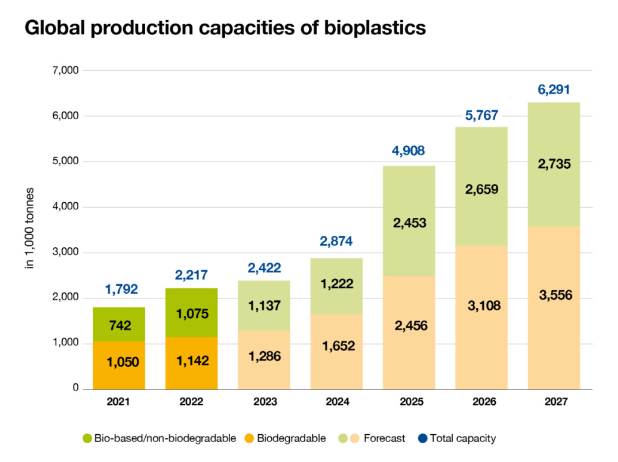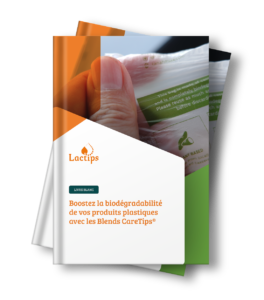The packaging industry is gradually turning towards more sustainable packaging solutions, composed mainly of bio-based and/or biodegradable materials. Although this transition is necessary, finding a balance between environmental and economic aspects is crucial.
In this article, we will address the financial issues that condition the widespread adoption of biodegradable materials.
What are the main biodegradable plastic materials?
PLA
This aliphatic polyester is obtained from sugars such as corn starch, beet, or sugarcane.
It is the oldest and best-known biodegradable plastic, compostable in an industrial environment.
PHA
This polymer is naturally produced by microorganisms, 100% biodegradable and compostable both domestically and industrially.
PHA is mainly formed by injection molding.
PBS/PBSA
Poly(butylene succinate), or PBS, is also a polyester. While it was long produced from petro-sourced materials, current PBS is generally 50% bio-based and mostly compostable.
PBSA, or polybutylene succinate adipate, is 35% bio-based, very flexible, and biodegradable.
Le PBAT
Poly(butylene adipate terephthalate) is a biodegradable polyester copolymer. Highly flexible, it is a very good candidate for replacing PE film packaging.
Other materials and innovations
Other materials exist, including starch-based compounds, cellulose, and BioTPE. Among these partially bio-based materials, some references are also biodegradable.
| Biodegradable under what conditions? | Industrial compost | Home compost | Soil | Water |
| BioTPE (TPU, SEBS, etc.) | Some references | No | No | No |
| PLA | Yes | No | No | No |
| PHA | Yes | Yes | Yes | Yes |
| PBS/PBSA | Yes | Yes | Yes | No |
| PBAT/PCL | Yes | Yes | Yes | No |
| Cellulosic | Some references | Some references | Some references | Some references |
| Starch based | Yes | Yes | Yes | Some references |
Source: Presentation of NaturePlast during the Polyvia Materials Purchasing Day, organized in October 2021.
| The importance of accelerated biodegradation
Most biodegradable polymers on the market are certified as biodegradable for thin products, around a hundred micrometers thick, and some manufacturers achieve up to a millimeter in standardized tests for home composting, but without certification. Fortunately, it is possible to accelerate this biodegradation by adding additives (including enzymes and bacteria) or by mixing the material with a biodegradable polymer such as CareTips® resin. |
Biodegradable polymers: more expensive than traditional plastics
According to Polyvia, in October 2023, the prices of polyethylene were as follows:
- LDPE : between 1,55 and 1,65 €/kg
- HDPE : between 1,60 and 1,70 €/kg
- LLDPE : between 1,75 and 1,90 €/kg
Comparing these figures with the prices of bioplastics, we can see that:
- BioPE is at least twice as expensive as HDPE or LDPE
- The price gap reaches a factor of 5 for biodegradable polymers such as PHA and PBS
| Polymer | Availability | Price range (€/kg) | Biodegradable |
| BioPET | Limited offers | 2 to 2,5 | No |
| BioPE | High demand, tight market | 3 to 3,5 | No |
| BioPP | Limited capacities | 3,5 | No |
| BioPA | Often made to order or high demand | 6 to 18 | No |
| BioTPE (TPU, SEBS, etc.) | Often made to order | 5 to 8 | In some cases |
| PLA | High demand, new players entering | 3 to 3,5 | Yes |
| PHA | Limited capacities | 6 to 8 | Yes |
| PBS | High demand, tight market | 4 to 8 | Yes |
| Cellulosic | Good | 4 to 6 | In some cases |
| Starch based | Good | 4 to 5 | Yes |
Source: Presentation of NaturePlast during the Polyvia Materials Purchasing Day, organized in October 2021.
What are the financial constraints for manufacturers of biodegradable polymers?
- Cost of raw materials
As mentioned earlier, the high costs of bioplastics do not encourage industrialists to use these materials.
These costs are partly due to the use of more expensive raw materials such as starch, vegetable oils, and cane sugar. However, this situation is expected to evolve thanks to innovation.
- Cost of adapting production equipment
The production of bioplastics requires different manufacturing processes from those used for traditional plastics, notably involving processes from the biotechnology sector.
Adapting current processes requires investments and thus entails additional costs for industrialists.
How to generalize biodegradable alternatives and increase their profitability?
Economies of scales
This is one of the main levers to reduce the cost of biodegradable materials: accelerating production to achieve economies of scale and increase the availability of these new materials.
The situation is expected to evolve in the right direction: according to European Bioplastics, the annual production capacity of bioplastics, whether bio-based or biodegradable, will be multiplied by 3 by 2027.

Innovation in production
Innovation also plays a significant role in reducing production costs. The emergence of new, simpler, and more environmentally friendly production processes will thus lead to obtaining less expensive materials.
Example: In the “classic” PLA manufacturing process, the lactide used is synthesized via a two-step process that is very expensive and generates a significant amount of waste.
Two Belgians, Michiel Dusselier and Bert Sels, have developed a PLA manufacturing method with a single step, using a catalyst based on synthetic zeolite. This innovative process, which is less energy-intensive and economical in raw materials, could reduce the total production cost of PLA by 30%.
Regulatory developments
The current European regulations tend to favor recycling, which slows down the emergence of biodegradable solutions.
However, the growth of biodegradable polymers seems inevitable, given the projected explosion in global plastic consumption.
| Collection bags for biodegradable polymer piowaste: an ADEME approved application
Several European countries have already implemented the collection of biowaste, and France has been part of it since January 1, 2024. For collection, Italy, which is a leader in this field, has opted for the use of biodegradable plastic bags. In France, ADEME also considers this solution relevant if it “contributes to increasing the quantities of valorized biowaste and does not disrupt waste treatment channels”. |
Conclusion
Available biodegradable materials are increasing, and new innovations will continue to emerge in the coming years. However, their adoption by industrialists will depend on their accessibility in terms of both economics and production capacity.
Facing with the risks of scarcity or rising costs, packaging industry professionals will also need to demonstrate resilience, notably by integrating the use of multiple materials into their processes.
Do you want to boost the biodegradability of your plastic products?



